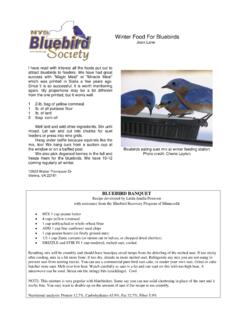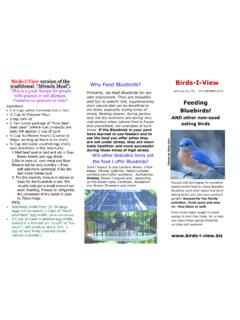Transcription of Time of Day of Egg Laying by Eastern Bluebirds
1 SHORT COMMUNICATIONS 377 Wilson Bull., 107(2), 1995, pp. 377-379 Time of day of egg Laying by Eastern time of egg Laying varies among species. Most passerines lay their eggs shortly after sunrise, but several species lay their eggs well after sunrise (Schifferli 1979). The time of egg Laying is known accurately for relatively few species, partly due to the difficulty in determining when it occurs. An accurate assessment of the time of egg Laying can be important for studies of reproductive strategies. In most passerines, eggs are fertilized at 24-h intervals, and the next egg in a sequence is fertilized in the hour after the Laying of the previous egg. The time of egg Laying thus indicates the time of fertilization.
2 In species with sperm competition (Birkhead and Moller 1992), this hour after egg Laying should be the optimal time for copulation attempts, because inseminations will be most likely to fertilize the next egg. Consequently, this will also be a critical time for mate guarding by males against extra-pair mating attempts. We report here an estimate of the time of day of egg Laying in Eastern Bluebirds (Sialia sialis) using the method developed by Scott (1993) to analyze data we collected during a study of mate guarding (Meek and Robertson 1994). studied Eastern Bluebirds breeding in nest boxes near the Queen s Uni- versity Biological Station, Chaffeys Locks, Ontario (44 34 N, 76 19 W), from April to July, 1989 and 1990.
3 Most birds were unbanded at the start of this study, because we usually captured Bluebirds in the nestbox during late incubation or shortly after the young hatched. As part of a study on mate guarding, we observed the behavior of Eastern bluebird pairs before and during the egg- Laying period. We made half-hour nest observations between 04:30 and lo:30 h (EST). Following a nest observation, we checked the nest contents if we knew that the female was not in the box. In addition, we made regular checks of focal and non- focal nests after 12:O0. In this way, we obtained 145 nest check observations during egg Laying from 56 different females. All observations in this study were made between April 8 and May 10 on females Laying their first clutches.
4 Each time we visited a nest, we recorded the time of day and the presence or absence of new eggs in the nest. We assume that female Eastern Bluebirds lay their eggs at 24-h intervals, as is typical of passerines. The observations were categorized according to whether a new egg was present or absent and grouped into I-h time intervals. For each time interval, we calculated the proportion of nests containing a new egg. At the medium time of the daily egg- Laying period, the proportion of nests containing a new egg changes from ~50% to >50%. We then tested whether there was a significant change in the proportion of nests containing a new egg between the two time intervals adjacent to the interval in which about 50% of eggs were laid.
5 Further details of the logical basis and procedures of this method are in Scott (1993). We report all times as Eastern Standard Time (EST). new eggs were laid before 0:630 EST (N = 26 observations). A few eggs were laid before 07:00, and most new eggs were present by 09:OO (Table 1). Only three eggs were laid after 09:OO. Hence, the daily Laying period spanned about hours, from 06:30 to 09:OO. The proportion of nests containing a new egg changed significantly from 19% (4/21) between 06:01-07:OO to 86% (18/21) between 08:01-09:00 (G-test, G,, = , P < ). The proportion of nests with a new egg reached 50% between 07:Ol and 08:OO (Table 1). Hence, we estimate that the mid-point of this hour, 07:30, was close to the median Laying time for Eastern Bluebirds in Eastern Ontario.
6 Bluebirds have been reported to lay their eggs around 08:OO EST in Ithaca, New York (Hamilton 1943), and about 2 h after sunrise at 08:30 in Arkansas (Thomas 1946). Our results agree with those observations. Sunrise in Eastern Ontario is around 05:30 (EST) in April and 05:OO in early May (Weatherhead et al. 1991). All female 378 THE WILSON BULLETIN * Vol. 107, No. 2, June 1995 TABLE 1 THE NUMBER AND PERCENTAGE OF TIMES THAT A NEW EGG WAS PRESENT AT THE TIME OF THE OBSERVER'S VISITTO AN Eastern bluebird NEST Time of visit (EST) New egg Percent of nests (N) Not present with new egg 05:01-06:00 0 16 0% (O/16) 06:01-07:00 4 17 19% (4/21) 07:01-08:00 13 12 52% (13/25) 08:01-09:OO 18 3 86% (18/21) 09:01-lo:oo 22 2 92% (22/24) 10:01-l I:00 11 1 92% (11/12) After 12:00 26 0 100% (26/26) Eastern Bluebirds laid their eggs after 06:30, at least one hour after sunrise, and the median time of egg Laying (07:30) was around two hours after sunrise.
7 The timing of egg Laying varies considerably among species. For example Red-winged Blackbirds (Agelaius phoeniceus) lay shortly after sunrise, 04:37-0:601 EST (Muma 1986). Female Tree Swallows (Tuchycinetu bicolor) lay their eggs between 05:20 and 07:05 EST, or 05:57 on average (Venier and Robertson 1991). In Gray Catbirds (Dumetella carolinensis) the median time of egg Laying is 07:OO EST, about two hours after sunrise (Scott 1993), and in American Robins (Turdus migrutorius), a member of the same family (Turdidae) as Eastern Bluebirds , the average time of egg Laying is IO:32 EST (Weatherhead et al. 1991). The question of what time of day female birds should lay their eggs has not been fre- quently addressed.
8 As a result, only a few hypotheses regarding when a female should lay her eggs have been proposed. Schifferli (1979) suggested that females lay early in the morning to minimize constraints on their activity. Because eggs are most vulnerable to destruction late in development, if females lay early in the morning, the eggs are most vulnerable at night when females are inactive anyway (Schifferli 1979). However, having an egg in the oviduct does not constrain activity of female American Robins (Weatherhead et al. 1991). Weatherhead et al. (1991) suggested that the timing of egg Laying may result from selection on the optimal timing of fertilization or on the best time for copulations. Recently, Scott (199 1) examined whether egg Laying before sunrise by female Brown-headed Cowbirds (Molothrus aler) was a specialization for brood parasitism.
9 Female Brown-headed Cowbirds lay their eggs on average 9 min before sunrise, whereas seven potential host species all lay their eggs after sunrise (Scott 1991). Laying before sunrise may be advanta- geous to female cowbirds, but there are insufficient data on other icterines to assess whether early Laying arose as an adaptation to brood parasitism (Scott 1991). Finally, foraging strat- egies may influence the timing of Laying . Aerial insectivores such as Tree Swallows must spend considerable time in flight and should oviposit early in the morning, both to increase their flying efficiency during the day and because foraging probably improves with time of day as the temperature increases and insects become more active.
10 Species such as Eastern Bluebirds or American Robins which forage on the ground or from a perch do not need to fly as much, and holding an egg is probably of little consequence to foraging efficiency. These hypotheses have not yet been adequately tested, and there may be other equally plausible hypotheses that explain the timing of egg Laying in birds. Most likely the timing of egg Laying will be influenced by different factors in different species. SHORT COMMUNICATIONS 379 thank Caroline Tomlin for assisting with the field work, and David Scott and an anonymous reviewer for their reviews. The Queen s University Biolog- ical Station provided logistical support. Funding was provided by the Natural Sciences and Engineering Research Council of Canada, the Canadian Wildlife Service, the North Amer- ican bluebird Society, and the Animal Behavior Society.












